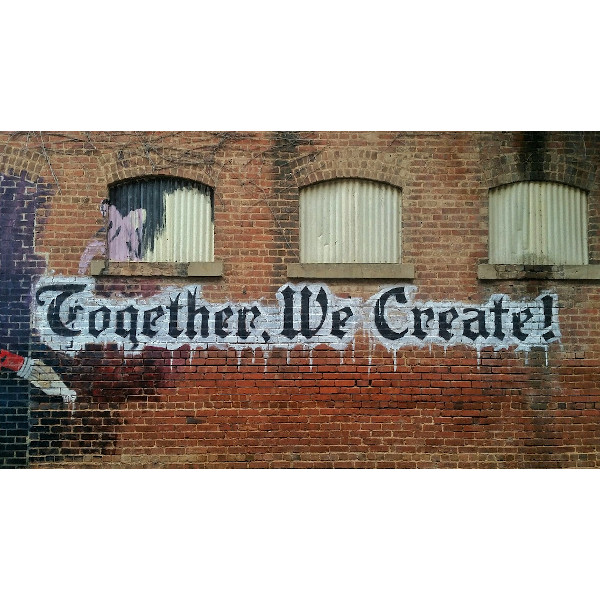This post is a significant revision of part of an internal document I wrote and shared within the Nonviolent Global Liberation (NGL) community. I am sharing it publicly because I believe that the lessons within it can be of service to many who are not part of NGL and who, like us, are grappling with the paradoxes of co-creation.
Co-creation has been a central aspect of NGL literally from the very start. When I brought the initial idea of it to a residential retreat I led in 2017, one person present, Kasper Lemiesz, proposed to have an entire group design NGL rather than just me and the two others I had invited to co-hold it with me, Verene Nicolas and Uma Lo. I immediately accepted it with joy and no reservations, and to this day I believe that initial turn of events is the seed of everything we still have. The design team that emerged met only once: to create various teams and to distribute responsibility for making things happen. We entrusted different systems and aspects of functioning to different teams and we all implicitly accepted imperfection as we kept moving forward with what was unfolding. To this day, many of the teams within NGL engage in projects and activities I mostly know nothing about and have little to no input into.
I am also entirely unsurprised that I instantly said “yes” to him. I have been oriented towards collaboration and co-creation long before I discovered Nonviolent Communication and all the dramatic changes brought to my life through embracing and living from its worldview. I have always loved what happens when we come together and find collective wisdom and I have deep trust in humans’ innate capacity to collaborate for better solutions than any of us on our own can see. When I was working in a software company in the 1980s, I turned down a managerial title when taking on a massive new project because I wanted to bring people together to work on it based on intrinsic motivation. I also wanted to work out what we would do without people deferring to me, which I thought would happen if I had a title. That project flourished as a cross-departmental collaboration for two years without a single conflict until I left that company.
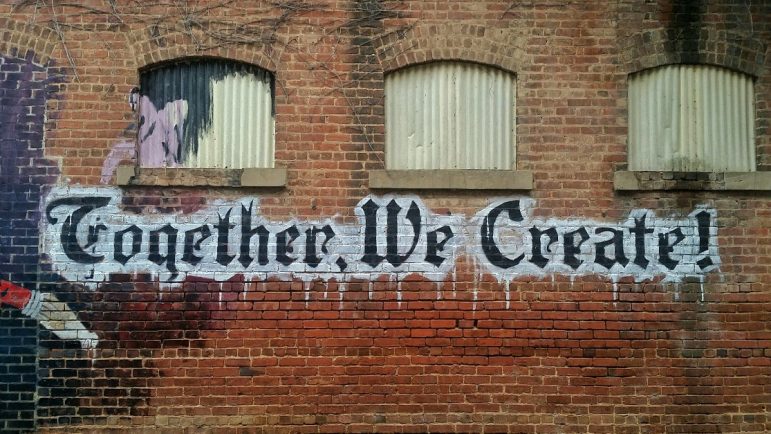
Co-creation is not equality
Simultaneously, I don’t see co-creation and collaboration as requiring everyone to be equal. Since we don’t have equal needs nor equal capacities, I have long struggled to understand what “equality” even means. The only kind of equality that has ever made sense to me is the one proposed by Evelin Lindner when she speaks of “equality in dignity”. For me, this speaks to reverence, to our singular self being a form of life, sacred, irreplaceable, magnificent. It speaks to the depth of care and wanting everyone’s needs to be attended to well. That equality of dignity isn’t about being the same.
If one of us has many years of experience with something and others are earlier on the journey, there is ample reason to give more weight to the person with more experience. We have different strengths and different limitations and I long for us to collaborate and co-create with that in mind, while leaving room for the mystery that a path forward may open through someone else with far less knowledge, experience, or sometimes even clarity. As my sister Inbal told me, by the time he was two, my nephew would come up with solutions that adults didn’t conceive of about 25% of the time when she and her wife Kathy engaged with him at times when he wanted one thing and they wanted something else. Leaving open that possibility meant that they neither had to impose nor give up: they all, together, held those moments until a solution arose. This is what life and mystery create.
Still, both in the example of my nephew and in the example of the early phases of NGL, the co-creation isn’t held within a horizontalist field. In the weeks leading up to the one historic meeting of the design team, we all worked on a design document that was the foundation for what we reviewed and decided at that meeting. And, while many people offered input and feedback, I was still the one who drafted it and who integrated the input into the final version. I would estimate that I did at least 90% of the work and 99% of the holding of that work. This still means co-creation, and it’s co-creation in a led field.
My intuitive sense is that intact communities, where they exist, have a web of communal relationships and trust that means organic weaving can happen without any specific form of leadership, because different people can step into leadership simultaneously in interdependent ways. The combination of the depth of trust, the web of relationships, and the clarity that anything anyone does can impact the whole community may be enough for this kind of flow to occur. My belief is that even then there are people with natural authority who may be offering leadership within the community so seamlessly that it isn’t even a big deal within pockets of such deep trust.
In the patriarchal social order in which almost all of us live, such trust is almost entirely gone. When we come together with a shared purpose, especially one intended to create social transformation of one kind or another, imagining that a horizontalist structure is both desirable and possible is worrisome to me even though the sentiment is close to my heart and I totally get the systemic mistrust of anyone in any position of leadership. My concern is that in the absence of actual, material ties, there isn’t enough of a web for emergent ways of functioning. I want, instead, to create pockets of enough shared purpose and enough willingness to entrust that those of us who have more capacity, at least to envision and live into alternatives, can offer what we have without the criticism and ongoing conflict that plague most groups and movements.
I want to use our shared risk pod as an example, because this is precisely how we function. There is no equality in anything we do and no fairness. I do far more of the intangible holding of many things than others, especially offering integrative pathways and ways of framing things, and far less of the practical, because we all recognize me to have nonredundant capacities. This is one of the few places I have anywhere where I am simultaneously and fully seen as an ordinary human being and as someone with unusual gifts and where neither one cancels the other. Everything that emerges from within us emerges from co-creation, and we all know it even when it’s not specifically clear who contributed what and even when it’s clear that I have specific authority and understanding in certain areas. I don’t have a sense that anything has ever been imposed on anyone, though we have, at times, taken on agreements that we refer to as “rules” where we voluntarily relinquish choice in an area where we know that we don’t actually have it and need to follow for a while until we can find the true internal muscle. We are a “we” that knows itself as such. I am the one who does a lot of the framing and the writing, and the substance from where it arises is us and our experiments.
Co-creation of the kind I long to see thrives on deep trust that makes possible the free flow of information about needs, impacts, and resources. This is our general baseline, even if any of us lose it in this or that moment. Our togetherness is breathtaking. Specifically in relation to me, everyone here trusts me that I want all the truth, even if it’s painful; that I never want anyone to defer to me unless I say so explicitly (which hasn’t yet ever happened); that when I express myself with intensity it’s because of wanting togetherness, not because of anger; that I will always say if I am angry or have judgments and that when I say I am not, I am not; and that I want to hear impacts of my actions even though I lost, maybe forever, the will and capacity to listen to and transform judgments of me. It’s astonishing to me how rarely impacts shared within our pod are about me. Rarely, and not never, or I wouldn’t trust that people are honest with me.
The challenges to co-creation that visionary leaders face
I am someone with a lot of capacity in many areas. I sometimes joke that I write faster than people can read what I write… Because of this, and because I am explicit about my unique position as visionary leader within NGL, some phenomena occur within NGL that I believe can shed light on what may happen, possibly less explicitly, elsewhere. In that way, I hope our experience can be a gift to the whole.
The overall phenomenon is the way that so many of us relate to pockets of high capacity and of leadership as being at odds with co-creation. Instead, some people resort to pathways that I personally find immensely painful.
Deference
Some people go along with what I do without engaging their full self, their discernment, their perspectives, wishes, and understandings. This is painful for me for two reasons. One is that I never ever want people to give up their own being in order to be with me; it grates on my soul that anything I do or, worse yet, just the sheer beingness of who I am, can lead people to give up on their own power. The other painful part is that more often than not, I don’t even know about it, because so many people are habituated to defer and can do so while maintaining friendliness and warmth. Since I often use the latter as indicators of trust, a gap is created.
This is easiest to make sense of through the lens of the “freedom triangle” and “security triangle” framework that my sister Arnina created.1 Freedom-dominant people like me usually don’t have the capacity to be warm and friendly when not feeling freedom. Security-dominant people, on the other hand, are so used to sacrificing their freedom for belonging that they do this, likely without even knowing, without even having a sense of the gap within the relationship. Discovering this later is particularly wrenching for me and taps into one of the few areas of harsh self-messages, where I berate myself for having trusted people too much.
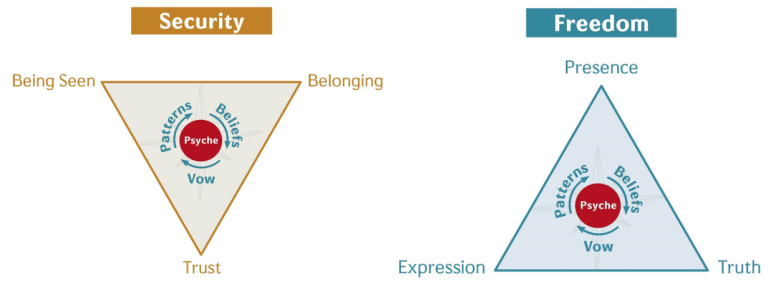
Separation
Some people learn what they can from me and then separate and “do their thing” elsewhere. They genuinely love what I do and want it to be out in the world influencing the unfolding of human affairs. They even want to contribute to that with their own work. And they don’t find a way to do it with me. So they go elsewhere and do other things, often fully based on what they learned from me, and without continuing to nourish what I can do. The pain here is that some of these people are near and dear to me, including a few close friends. And I am aching to be able to collaborate, to learn together, to increase our collective capacity to meet the immense challenges of current human life.
Rebellion
Some people engage with me and my work primarily by challenging it. They clearly value what I am doing. They clearly see themselves as having something to contribute to it and to the world. And, instead of doing that with me, they challenge what I am doing. The degree to which I often experience myself as not trusted is regularly overwhelming to me. I am quite weak in being able to understand this path, though I see it quite often. Is this happening because of the capacity gap that makes it so hard? Is it that the vision is compelling and the capacity gap is too overwhelming to be within softly? Are there harsh self-judgments that turn into judgments of me? Is there fear and mistrust that articulating concerns vulnerably will result in negative responses from me or others? I don’t know, I can’t guess, and I suffer with this one most acutely. The amount of tension, mistrust, judgment, distance, harshness, and other forms of separation that I absorb in the course of my leadership is an ongoing grind, weakening my resilience. I know it’s not visible to people, as even there my capacity is high: I am able to absorb beyond what many can and to remain open, curious, engaging, capable of integrating, and calm even when I have taken in some amount of separation energy coming my way.
Walking towards co-creating with visionary leaders
Some people, thankfully, have chosen a different path. They have understood and accept the invitation to see my passion and my capacity as my unique gift to all of us. They are able to treasure it and nurture it within me, to step up to the fullest of what only they can offer (and not me!), and to join me and others who have already done that. It means entrustment rather than deference, togetherness rather than separation, and deep and vulnerable mutual engagement instead of rebellion.
And this isn’t unique to me, either. I see infinite potential in people finding ways of walking towards visionary leaders like me, joining without ever giving up on self, and seeing clearly the existence of a path of liberation and empowerment for anyone taking it and for all those whom they touch. Along the way, this path is also of immense support to visionary, collaborative leaders like me.
Just like in our pod, this doesn’t mean always agreeing to what a visionary leader like me says, and it does mean giving extra weight to what we say. People who step into it recognize that they need to trust themselves, even when I speak with passion and conviction (my usual style), so as to keep discerning what is true for them, regardless of what I say and in deep consideration of what I say. And it means trusting me, and trusting the entire field of our togetherness, even in moments of challenging disagreements. That, for me, is the most significant place where this finds expression: how we engage with dissent. Dissent within trust is an entirely different animal than either an avoidance of expressing dissent or expressions of dissent that are critical, challenging, or questioning. I want all the dissent in the world, said into a togetherness that is unshakable.
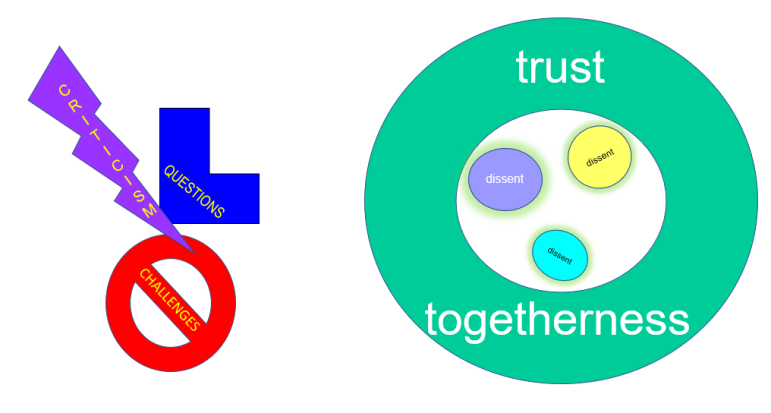
To me, growing the capacity to express dissent from within trust is key to our future. I see a deep need, anywhere and everywhere, to reweave our collaborative bonds. We also need to learn, somehow, how to expand the circle of trust to ever more people, eventually to all of us and to life as a whole. This is a deep antidote to patriarchy precisely because patriarchy is loss of trust in life that is the foundation on which the scarcity that leads to separation and powerlessness rests.
To the best of my understanding, leadership has always existed. My native language of Hebrew, for example, has had the same word for leader for almost 2,000 years. The word in Hebrew, just like the word in English, derives from a root that has to do with direction and movement.
What has changed, I believe, is both how people end up in positions of leadership, what qualities are seen as important, and what the word connotes. In many matriarchal longhouse communities, the woman that becomes the leader, if she’s not implicitly the one whose offspring live in the house, is the one selected for her greatest capacity to care for everyone. She is held with care and respect, and she isn’t separate from the rest of the community. The tightness of the bonds with community and land makes it near impossible that she will become separate or exercise control over other people.
In patriarchal societies, in painful contrast, people become leaders based on their capacity and willingness to exercise power over others, as well as based on their social location. Patriarchal societies, from their beginning, are stratified. People are divided into groups and only some groups are considered deserving, even before the word may have existed. This form of leadership emerges from and then reproduces and perpetuates relationships of separation and domination. Leaders stand apart and are served and feared.
Tragically, the latter meaning of leadership continues to enter our experiences and thoughts about leadership. This is particularly significant in settings where community is still a primary and meaningful context within which all else happens – which mostly happens in the global south. This distortion in relation to leadership often means that people who are based in such settings, where care for all is part and parcel of community life, can easily experience confusion in relation to what can be seen as a preoccupation with leadership and a dangerous move against the fabric of community. Any of us who are immersed in a context of increasing our capacity for leadership as care for the whole will need to exercise immense care if we ever work with intact communities and want to support empowerment and leadership. Otherwise, this can easily follow pathways established by colonization and interfere with the flow of trust and relationships within the community.
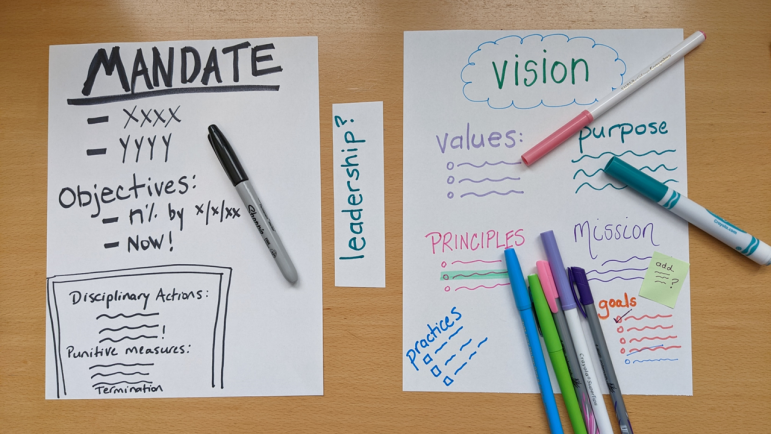
An alternative to abdicating power
I am slowly learning that co-creation of the kind I am longing for and believe is necessary for humanity cannot happen when leaders like me step back and leave voids that are beyond collective capacity any more than it can happen in the more common situations in which visionary founders maintain habits of control and shape all that happens.
When I look at my own track record, I see that I have abdicated power too much and too early in too many projects, in part as a distorted expression of a commitment to never impose anything on anyone. This tendency has intensified within NGL because my goal, from the start, has been to have enough capacity around me to carry the work forward once I am not here. Every step of the way, in every aspect of the work, this has meant aiming to support leadership to emerge around me and discerning when to step aside when enough has been integrated elsewhere. I deeply long for more co-holding, tenderness, creativity, and support in relation to how difficult and unprecedented this task is that I took upon myself. I know of nowhere else where this is done with the degree of determination, conscious choice, and transparency that I am holding.
The script for this movie isn’t written anywhere. Writing it is, by necessity, in itself an act of co-creation for which everyone is needed. For this to succeed, as part of creating a field of love that is large enough to surround and transmute the patriarchal field, I see it as essential to surround with tenderness anyone who dares to experiment, as I do, with new forms of co-creation. This will require rigorous support for finding and transforming judgments of leaders and for identifying, for each person and in each context, what is anyone’s unique gift, what is theirs to do. And then it means stepping into leadership alongside and in togetherness with what existing visionary leaders do instead of criticizing or distancing from what anyone is already doing. We all need to come together with all our power for what is at stake now.
Finding what is ours to do is a key practice for these times, about which I wrote an entire article called “What’s Mine to Do? Vision, Action, and Mourning in the Face of Collapse.” Part of co-creation is for everyone to do it, both visionary leaders like me and those who are called to serve with us. The tapestry that emerges is what shapes the co-creation in the unique context of gifts, limitations, needs, and purpose that each configuration of humans will form. Co-holding the entirety of this is the foundation from which full co-creation can happen within a led field.
The unique role of visionary leaders
For me, as a visionary leader within a project I hold with such passion, this means finding what is, truly, mine to do, and no one else’s, now and until I die.
In much of the literature about leadership, I have found people writing in ways that have been intensely uncomfortable for me. Frederic Laloux is a prime example of it. As much as he talks about self-management, there is a deep role in what he discovered in the organizations he had studied for a visionary leader who is the one who can listen to what is wanted on behalf of the whole. In this, he follows the work of Peter Koenig about what Koenig calls “source“. Every initiative, says Koenig, starts from a need that lives in the person who is “source”.
From the moment I encountered this body of work, I have felt some aversion and resistance to it. I don’t want it to be true. I don’t believe anyone has explored the relationship between the phenomena that Peter Koenig has researched and patriarchal conditioning. It is heavily focused on a single leader who is the one with access to the information channel from which vision emerges for the initiative that person is holding. I remain unconvinced that this simple structure is, as claimed, universal. I believe it’s likely true in many contexts, and not universally or by necessity.
In some contexts, especially the pod and the group that surrounds and supports us, I believe we have come into sufficient choice within togetherness and sufficient flow within how we function that there is no one “source” for anything. What we create emerges organically in multiple spots, and not necessarily with me.
In the rest of NGL, we are not there yet. One colleague and friend who is no longer part of NGL found a simple way to bring it to my attention. She expressed a concern within this area in relation to some people “claiming that things are more egalitarian when, in truth, there is a needed acknowledgement [within the community] of your role Miki.” When she said it, I was shaken up and upset, and, still, as uncomfortable as I may be about the theory of source, I recognize the truth of what she said. My resistance isn’t to that; it’s only to two things. One is the separation and the implication of top-down decision making that is there. The other is the implication that it’s infallible.
Even with the deep commitment to work with others, not alone; even as I don’t really ever want to make any decisions by myself and always want to have people with me, co-holding everything; even as there is some integration with the inherent advantage of collaboration and emergent wisdom that is missing for me in what I have read so far about “source” theory, I also know without any shred of doubt that vision lives in me in a particular and unique way. In that sense, it is part of what’s mine to do, a place where I have a unique role. Trying to override it or overrule that truth is likely to only interfere with NGL’s coherence and capacity to move.
Within this, it is also totally mine to be the one to sense and be an ultimate authority on the work itself, the content of what we bring to the world, especially in how this relates to integration of liberation from patriarchy, as this is one of the deepest places within the work I do where vision intersects with practicality.
Co-creation with any visionary leader who holds the entirety of the whole, including preparing for their own work to outlive them, happens in a context of differences in what different parties bring to the collaboration: needs, perspectives, experiences, gifts, overall capacity, and more. What visionary leaders bring to such a context is, first and foremost, the vision itself.
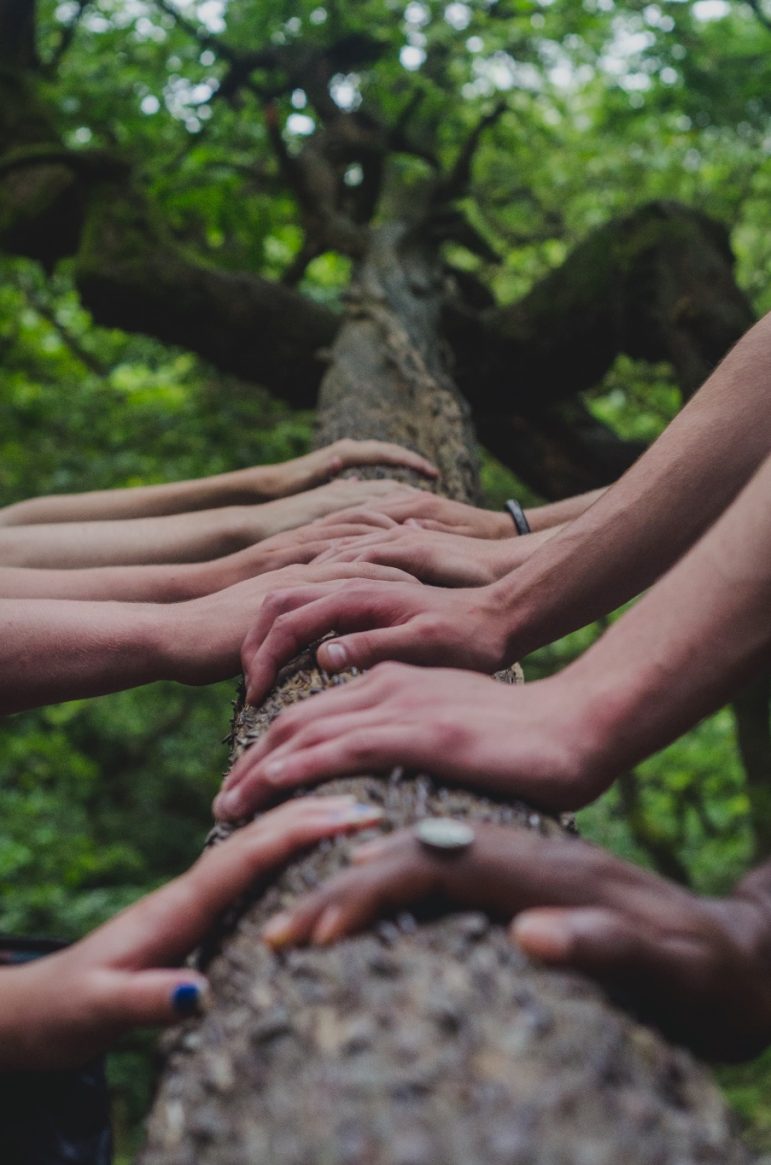
Fully empowered engagement with visionary leaders
Co-creating within a field held by a visionary leader happens in a context where a vision already exists. This is a nuanced statement, because any leader who deeply orients to vision is likely to be open to input and to organic shifting of what then happens, up to and including the humble willingness for the vision itself to be transformed over time. This has already happened to me, more than once, arriving at language and framing that would never have been my own to begin with. And that doesn’t mean that the vision is up for grabs to change. I still am the one holding it and sensing if any shift is still aligned with it.
For me, all this means that for co-creation to exist, those who are stepping into a led project need to be fully aligned with the vision to the point of being able to embody it and represent it to others. It also means joining into values, purpose, and a host of foundational agreements that already exist. Again, this doesn’t mean compliance or deference. It simply means that if alignment isn’t there for anyone, it isn’t going to work for that person to actually join. There’s never a request of anyone to change who they are, what their vision is, or how they want to go about things. There is, however, an expectation that people only join if they are aligned. There isn’t going to be capacity or a reason that is grounded in purpose (rather than in habitual expectations) for people in positions of visionary leadership to make themselves available to engage in reconsidering what the vision or other foundational agreements are going to be. This is why the made-up word proclusion is so significant, because it points to a new way of being together: through alignment, not through relational affinity or simple inspiration about something.
This way of functioning, I believe, is the integration beyond top-down control and power-over on the one hand and the anti-authoritarian, horizontalist reaction to it on the other hand. Neither of them, to my mind, speak to what is organically aligned with life in these times of teetering on collapse.
When we manage to get there, co-creation can be fully empowered for everyone, most of the time. Getting there is tough. It requires a lot from everyone to climb out from the patriarchal conditioning we come into it with. It requires of leaders like me something I am still not fully able to do: working to support liberation and empowerment for everyone while simultaneously finding capacity to state limits, hold vision and purpose firmly, and keep offering guidance until it’s really not needed any longer because integration has happened. My own capacity limits are in overestimating people’s capacity in multiple areas and thus releasing leadership too soon; not being sufficiently aware of how little capacity to express dissent so many people have and not taking in sufficiently how much deference can exist without being explicit and visible; and being too reluctant to name the limits of the container within which collaboration happens. In the last few months, I am feeling more hopeful about integrating these lessons sufficiently to be able to walk this complicated line.
For others, the challenge is no smaller. It means continuing to see the humanity of leaders, to hold tenderness for where visionary leaders find the edges of their capacity to do all the above, and to offer support and co-holding wherever possible. It means really and fully taking in that offering lots of feedback to visionary leaders for everything that isn’t working within an environment clogs the system and blocks the channel of life that flows through a person, which then has impacts on everyone, not only on the leader who absorbs too much. And it means finding the courage and the inner trust to act, initiate, integrate, offer support to others who may be struggling with these transitions, and overall step into full leadership alongside the visionary leader.

In any community, movement, or organization that takes on this difficult transition and successfully navigates it, I see a bright possibility of reaching a level of capacity to mobilize coherently towards the immense task of what is ours, collectively, within that group, to do as our unique collective contribution to the possibility of humanity still having a future. Some of us will be in visionary leadership roles in any such group, and within such contexts there’s room for all of us to co-create so long as we recognize the possibility and show up, within it, in our fullness.
1 See the article “Parenting without Obedience: A Preliminary Guide to Intergenerational Collaboration,” that Arnina and I co-authored, Tikkun, Winter 2019.
PHOTO CREDIT
- Create mural Photo by “My Life Through A Lens” on Unsplash
- Security and Freedom triangles by Arnina Kashtan and Hila David
- Contrast criticism and trust image by Leslie Becknell Marx
- Contrast 2 modes of leadership by Leslie Becknell Marx
- Hands on tree Photo by Shane Rounce on Unsplash
- Path of flowers Photo by Pixabay on Pexels
